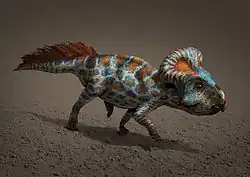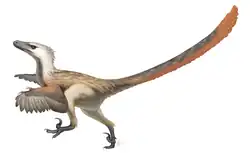Minhe Formation
| Minhe Formation | |
|---|---|
| Stratigraphic range: Late Cretaceous,[1] | |
| Type | Geological formation |
| Overlies | Unconformity: Hekou Group |
| Lithology | |
| Primary | Red or variegated clastic rock |
| Location | |
| Region | Gansu, Inner Mongolia |
| Country | |
The Minhe Formation (simplified Chinese: 民和组; traditional Chinese: 民和組; pinyin: Mínhé Zǔ) is a geological formation in northwestern China, whose strata date back to the Late Cretaceous period.
Dinosaur remains are among the fossils that have been recovered from the formation.[2]
Vertebrate paleofauna
Dinosaurs
A tyrannosaur tooth with a split carina has been recovered from the Minhe Formation in China.[3]
Color key
|
Notes Uncertain or tentative taxa are in small text; |
| Dinosaurs reported from the Minhe Formation | ||||||
|---|---|---|---|---|---|---|
| Genus | Species | Location | Stratigraphic position | Material | Notes | Images |
|
H. pachycephalus[4] |
|
"Badly preserved cranial and postcranial fragments."[5] |
  | |||
|
M. gobiensis[4] |
|
"Teeth, fragmentary jaws and postcrania."[6] |
||||
|
M. sulcidens[4] |
|
"Tooth."[6] |
||||
|
P. philemys[4] |
|
"Very fragmentary jaw with [one] tooth."[7] |
||||
|
P. andrewsi[8] |
||||||
|
T. bexelli[9] |
Inner Mongolia[9] |
Reclassified as a new genus of pachycephalosaur,Sinocephale and reidentified as provenant from the Ulansuhai Formation | ||||
|
V. mongoliensis[10] |
|
|||||
See also
References
- ^ Xi, D.; Wan, X.; Li, G.; Li, G. (2018). "Cretaceous integrative stratigraphy and timescale of China". Science China Earth Sciences. 61: 1–31. doi:10.1007/s11430-017-9262-y.
- ^ Weishampel, David B; et al. (2004). "Dinosaur distribution (Late Cretaceous, Asia)." In: Weishampel, David B.; Dodson, Peter; and Osmólska, Halszka (eds.): The Dinosauria, 2nd, Berkeley: University of California Press. Pp. 593-600. ISBN 0-520-24209-2.
- ^ "Tyrannosauridae," in Molnar (2001); page 347.
- ^ a b c d e f g h i j k l "3.3 Gansu, People's Republic of China; 1. Minhe Formation," in Weishampel, et al. (2004). Page 598.
- ^ "Table 21.1," in Weishampel, et al. (2004). Page 466.
- ^ a b "Table 22.1," in Weishampel, et al. (2004). Page 480.
- ^ "Table 17.1," in Weishampel, et al. (2004). Page 368.
- ^ a b "3.3 Gansu, People's Republic of China; 1. Minhe Formation" and "3.3 Nei Mongol Zizhiqu, People's Republic of China; 3. Minhe Formation," in Weishampel, et al. (2004). Pages 598-599.
- ^ a b c d e "3.3 Nei Mongol Zizhiqu, People's Republic of China; 3. Minhe Formation," in Weishampel, et al. (2004). Pages 598-599.
- ^ a b Listed as "cf. Velociraptor mongoliensis" in "3.3 Nei Mongol Zizhiqu, People's Republic of China; 3. Minhe Formation," in Weishampel, et al. (2004). Pages 598-599.
Bibliography
- Molnar, R. E., 2001, Theropod paleopathology: a literature survey: In: Mesozoic Vertebrate Life, edited by Tanke, D. H., and Carpenter, K., Indiana University Press, p. 337-363.
- Weishampel, David B.; Dodson, Peter; and Osmólska, Halszka (eds.): The Dinosauria, 2nd, Berkeley: University of California Press. 861 pp. ISBN 0-520-24209-2.